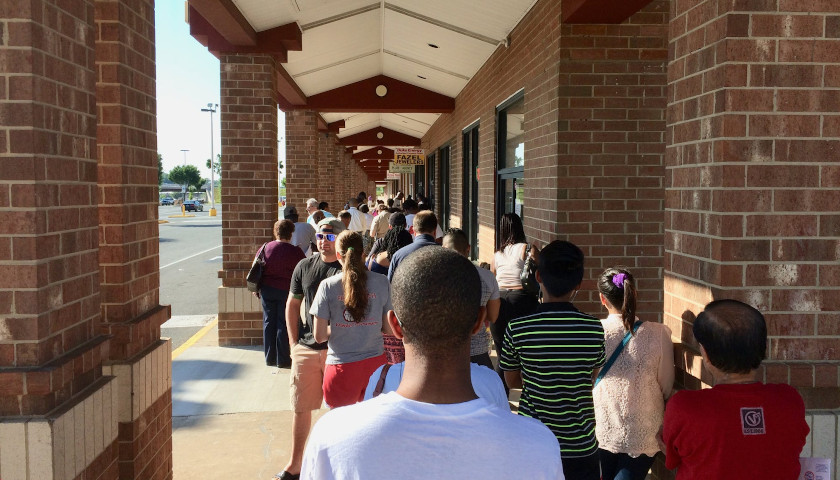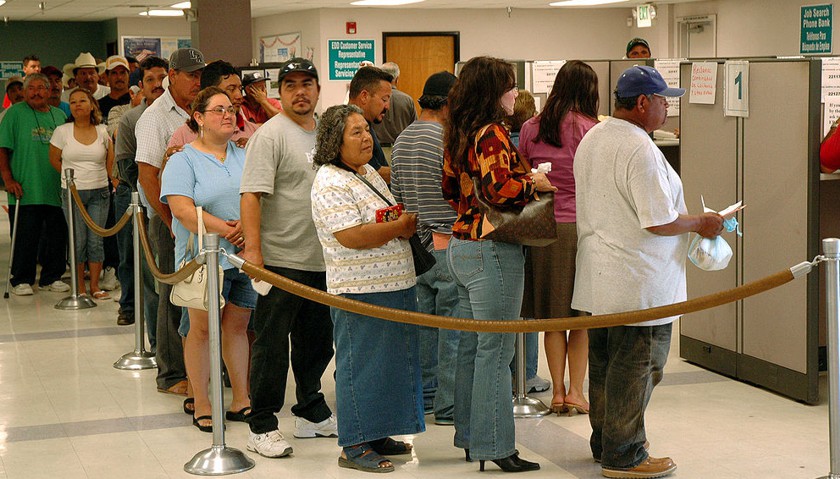Unemployment claims in Tennessee and nationwide continue to skyrocket because of the Chinese COVID-19 shutdown of businesses.
Read the full storyTag: unemployment
Minnesota Group Wants Unemployment Insurance for Illegal Immigrants
A progressive group in Minnesota wants state and national lawmakers to pass a “stronger unemployment insurance package” that includes benefits for illegal immigrants.
TakeAction Minnesota, a progressive community organizing group, released a list of policy proposals that it would like to see included in any stimulus package passed in response to the coronavirus pandemic.
Read the full storyEconomist Recommends Ohio Use Federal Stimulus to Bolster Unemployment Insurance Trust Fund
Following Ohio’s shocking unemployment rate increase of 2,565 percent, one economist says the COVID-19 coronavirus’ economic impact will be “long lasting” and provides a list of recommendations.
Read the full storyDeWine May Cut State Budgets by Up to 20 Percent, But Public Sector Cannot Match Loss of Private Sector’s 188K Lost Jobs
Even as Ohio Gov. Mike DeWine orders state departments to cut up to 20 percent of their budgets and implement a hiring freeze, state workers are not feeling the coronavirus economic burn like the private sector.
Read the full storyCommentary: Senate Paves Road to Reopening the Economy with Coronavirus Relief Bill, But When Will States Reopen Schools?
By a vote of 96-0, the U.S. Senate has passed a $2.2 trillion legislative package, by far the largest in U.S. history, to keep tens of millions of Americans on payroll and expand unemployment benefits to those who are laid off while the country waits out the deadly Chinese coronavirus that poses additional risk to seniors and those with underlying conditions.
That way, when the virus passes, those businesses, particularly the 30 million small businesses that are struggling most of all right now, but also critical industries, will be able to rapidly reopen and we can get back to our lives.
Read the full storyOhio Hit Harder with Unemployment Than Other States
Ohio was hit harder with unemployment filings than other states during the immediate aftermath of the coronavirus.
The U.S. Department of Labor reported Thursday that 3.28 million claims were filed in the week that ended March 21. That marked an increase of more than 3 million claims over the week prior, when 282,000 claims were filed, The Ohio Star reported.
Ohio’s claims totaled 187,784, the Cincinnati Enquirer said, up from 7,046 the previous week.
Read the full storyMinnesota Had 116,000 New Unemployment Claims Last Week
Minnesota has seen 182,000 workers apply for unemployment insurance since the beginning of the coronavirus pandemic, Department of Employment and Economic Development (DEED) Commissioner Steve Grove said Thursday.
Read the full storyMichigan Unemployment Claims Reach Record High
The economic fallout caused by the coronavirus pandemic includes massive unemployment caused by government-mandated shutdowns of businesses throughout Michigan.
The U.S. Department of Labor (DOL) reported 129,298 Michigan employees filed unemployment claims last week. Government figures indicate that number has increased from nearly 5,338 people filing unemployment claims reported March 14, a difference of more than 123,960.
Read the full story3.3 Million File Unemployment Claims in U.S. – a Record Number
Nearly 3.3 million Americans filed unemployment claims last week, a record number as businesses were forced to shut down to help slow the spread of the novel coronavirus.
The U.S. Department of Labor reported Thursday that 3.28 million claims were filed in the week that ended March 21. That marked an increase of more than 3 million claims over the week prior, when 282,000 claims were filed.
The previous high in a single week, according to the department, was in October 1982, when about 695,000 claims were filed. The nearly 3.3 million claims filed last week is nearly five times the prior record.
Read the full storyMichigan Jobless Claims Spike, 55,000 Seek Benefits Over 3 Days
More than 55,000 Michiganders filed unemployment claims between Monday and Wednesday, according to the Department of Labor and Economic Opportunity (LEO).
Read the full storyWhitmer Expands Unemployment Benefits for Those Impacted by the Coronavirus
Gov. Gretchen Whitmer has issued an executive order extending unemployment benefits for Michigan workers impacted by the spread of the coronavirus in the state.
Under the expanded eligibility, unemployment benefits are available to workers who are sick, quarantined or immunocompromised and who do not have access to paid time off; workers who have “unanticipated family care responsibility” such as ill family or additional childcare responsibility due to school closures; and first responders who are ill or quarantined because of the coronavirus. The extended eligibility is in effect until April 14.
Read the full storyFebruary Jobs Report: 273,000 Added, Unemployment at 3.5 Percent
The U.S. economy added 273,000 jobs in February, while the unemployment rate was almost unchanged at 3.5%, according to Department of Labor data released Friday.
Read the full story2019 Was the Slowest Year for New Jobs in Ohio in a Decade, Economist Says
An economic expert says Ohio’s latest unemployment data show 2019 was the slowest year for new jobs in a decade — and the state lagged behind the nation in creating new jobs.
Read the full storyCommentary The U.S. Economy Grew Another 2.3 Percent In 2019, Making 2020 Look Awesome for President Trump
What ever happened to that imminent recession the mainstream media was reporting?
Read the full storyCommentary: The August Jobs Report Is Not ‘Mixed’ It’s Yuuge
The anti-Trump talking-down-the-economy crowd has America already in a recession, with POLITICO’s Morning Money leading its Thursday morning news with, “…manufacturing in recession and capital expenditures dropping, the strong consumer is the final leg holding up the U.S. economy. But the length of the workweek dipped in July, often a leading signal that employers are cutting back. A sharp slowdown in job creation could follow.”
Read the full storyAugust Jobs Report: 130,000 Jobs Added, Unemployment Remains at 3.7 Percent
The U.S. economy added 130,000 jobs in August, while the unemployment rate remained at 3.7%, according to Department of Labor data released Friday.
Read the full storyFAKE NEWS: Drudge Report Touts MarketWatch Article of Half-Million Jobs Lost When 2.2 Million Jobs Were Created
You might have noticed some alarmist reporting from Marketwatch and the Drudge Report implying the economy lost 500,000 jobs last year.
Read the full storyJuly Jobs Report: 164,000 Jobs Added, Unemployment Remains at 3.7 Percent
The U.S. economy added 164,000 jobs in July, while the unemployment rate remained at 3.7%, according to Department of Labor data released Friday.
Read the full storyMay Jobs Report: 75,000 Jobs Added, Unemployment Remains at 3.6 Percent
by Mary Margaret Olohan The U.S. economy added 75,000 jobs in May, while the unemployment rate remained at 3.6 percent, according to Department of Labor data released Friday. Economists predicted 180,000 jobs would be added and that wage growth would rise to about 3.2%, according to The Wall Street Journal. Jobs numbers for April were 263,000 jobs added, according to the Bureau of Labor Statistics report. After a decline in April, the number of persons unemployed for less than five weeks increased by 243,000 up to 2.1 million. The May jobs report comes on the heels of April’s job report that showed the lowest unemployment numbers in 50 years. The U.S. economy added 263,000 jobs in April, while the unemployment rate fell to 3.6 percent. Economists had predicted only 190,000 jobs added and a continued unemployment rate of 3.8 percent. Jobs growth has come back strong after February when just 33,000 jobs were added. The unemployment rate has held steady between 4 percent and 3.7 percent for more than a year before the April jobs report showed it drop to 3.6 percent. Prior to April’s report, the consistent unemployment rate suggested that workers are jumping back into the workforce…
Read the full storyUnemployment Claims Hit 50-Year Low
by Henry Rodgers The total number of workers claiming unemployment insurance fell to the lowest level in 50 years, the Department of Labor reported Thursday. The number of applications claiming unemployment insurance benefits dropped by 10,000, bringing the number of applicants to 202,000, the lowest recorded number since Dec. 6, 1969, when the U.S. workforce and population were much smaller than they are today, the Department of Labor (DOL) report said. The number is a positive sign for the economy as it implies fewer people are unemployed in the U.S. The total number of people claiming unemployment benefits in the U.S. has continued to decline since President Donald Trump took office. Unemployment benefits are available for up to 26 weeks in most states and pay eligible workers up to $450 per week. – – – Henry Rodgers is a reporter for the Daily Caller News Foundation. Follow Henry on Twitter. Content created by The Daily Caller News Foundation is available without charge to any eligible news publisher that can provide a large audience. For licensing opportunities of our original content, please contact [email protected].
Read the full storyUnemployment Jumps, Minnesota Loses 8,800 Jobs During Walz’s First Full Month
Minnesota’s Department of Employment and Economic Development, or DEED, released its monthly jobs report Thursday, and the results weren’t good for Gov. Tim Walz’s first full month in office. According to the report, Minnesota lost 8,800 seasonally adjusted jobs in February, and the unemployment rate climbed from 3 percent to 3.1 percent, compared to a national unemployment rate of 3.8 percent. February 2019 saw 1,364 fewer jobs than February 2018 and was the first month of annual job decline since July 2010. Of the 11 major industries, seven saw job declines, with construction losing the most at 3,800 fewer jobs. “The most significant decline this month was in construction, losing 3,800 jobs—not shocking given the brutal February we had,” DEED Commissioner Steve Grove said in a news release. “Along with that, we know that Minnesota faces dwindling labor force growth—we can’t have job gains without people to fill the positions.” The trade, transportation, and utilities industry dropped 3,000 jobs, while education and health care lost 2,300 jobs, and manufacturing lost 1,600. The largest gain was recorded in the professional and business services industry with 1,300 new jobs, followed by 1,000 new jobs in financial activities, and 400 new jobs in…
Read the full storyColorado Governor Extends Unemployment Benefits to All Federal Workers During Shutdown
Gov. Jared Polis (D-CO) has opened up unemployment benefits for all federal employees working without pay in the state as the government shutdown carries on. “I have authorized an emergency rule that makes unpaid federal workers eligible for unemployment benefits, whether they are reporting for work or not,” Polis said in a Friday statement. “Many federal employees can’t afford to go without a paycheck for a month or longer—Congress needs to re-open the government, but in the meantime, our state will do everything we can to help Coloradans.” Prior to his announcement, only furloughed workers were eligible for unemployment benefits, since the law requires people to be out of work, not just working without pay, to qualify. Polis’ office said that 2,416 furloughed workers had already taken advantage of unemployment benefits, according to Colorado Politics. Under Polis’ emergency rule, essential employees who have been working without pay, such as TSA agents or IRS workers, can now apply for unemployment benefits. “Those federal employees who are required to report for work are feeling the same economic squeeze as those who have been furloughed,” Polis said. “They should not be denied the immediate financial assistance provided by unemployment benefits while being mandated…
Read the full storyOhio Jobs Report: A Strong Year Ends on a Dismal Note
While 2018 was, overall, steady for job growth, the year ended on a sour note for the Buckeye State. The Ohio jobs report for December 2018 has been released and it appears to have been a disappointing month. While unemployment remained at an unchanged 4.6 percent from November to December, the number of unemployed increased by over 2,000. This is in contrast to an overall gain of more than 16,000 jobs in 2018. Some business sectors were hit harder than others. The private sector lost 500 jobs and, surprisingly, 4,300 jobs were lust in the retail market during the Christmas season. While the aggregate numbers still represent an improvement, they’re frustrating for many as the U.S. unemployment rate was 3.9 percent during that same time period. The disappointing numbers also pointed to a greater issue. Andrew J. Kidd, Ph.D., an economist with The Buckeye Institute’s Economic Research Center noted: Of continuing concern is Ohio’s labor force. The unemployment rate only fell slightly this year from 4.9 percent to 4.6 percent, while the labor force actually shrunk. This comes after United Van Lines released their annual report, which found more Ohioans had moved out of the state than moved into the state. If…
Read the full storyThe Most People in Nearly 20 Years Quit Their Jobs for Better Ones in 2018
by Tim Pearce Roughly 2.4 percent of the Americans in the workforce quit their jobs in the past year, the fastest rate since 2001, according to the Bureau of Labor Statistics (BLS). The BLS’s most recent version of the Job Openings and Labor Turnover Survey (JOLTS) found that an average of 3.5 million Americans quit their jobs every month in 2018. The data suggest that more people are leaving jobs to search for or take opportunities elsewhere for better pay or more prestigious positions. “For any type of employment search, you won’t find a better time than right now,” Thomas Moran, CEO of the staffing agency Addison Group, told CNBC Make It. Unemployment has remained at historically low levels since September, the sign of a tight labor market that should drive wages and benefits up as employers compete to attract and retain workers. “For many, [quitting] is a smart move, as there’s a clear advantage to increasing your earning potential by switching jobs,” Glassdoor chief economist Andrew Chamberlain told CNBC. So far, wage growth has remained below economists’ expectations, though wages have picked up in the past year. Wages hit 3.1 percent annual growth in November, the first time…
Read the full story‘Don’t Screw Us Over,’ Ohio Workers Warn Candidates
by Ramon Taylor Brandy Corwin likes that she can now wear makeup and nice clothes to work. That is because she is no longer working on the assembly line at the General Motors plant in Fort Wayne, Indiana. “I was laid off multiple times, and having a family, you can’t rely on that,” she said. For the past five months, Corwin, 28, has been working at Credit Adjustments, Inc. (CAI), a debt collection agency headquartered in her hometown of Defiance, Ohio, an hour outside the city of Toledo. Corwin was a third-generation manufacturing worker and thought the assembly line was her fate. But now, she no longer has to work overtime and weekends to make ends meet. “I finally have a good work-to-home life balance,” she said, “and I didn’t have that before.” Her two children “love seeing me come home dressed up,” Corwin said. “My son, he compliments me all the time: Wow, Mommy, your hair looks really nice,’ or ‘Wow, Mom, I love your dress,’ because I’m not walking home in dirty jeans and steel-toe boots.” CAI opened its first area call center in downtown Toledo last January, providing 60 new job opportunities, with the goal of adding…
Read the full storyGreat Economic News Bedevils Trump Detractors
by Rick Manning The incredibly positive economic data that keeps coming out from both private and public sector sources leads to one overriding question: Will the Trump economic detractors ever get tired of being wrong? Over the course of the past six months, we have heard how tariffs against the Chinese would be passed along to the consumers in higher prices — yet the just released inflation data from the Labor Department’s Bureau of Labor Statistics shows that last month the Consumer Price Index increased a seasonally adjusted 0.2 percent for all items with the past six months showing a paltry 0.8 percent increase for all items. The Federal Reserve target for inflation growth is 2 percent per annum and the past six months are tracking twenty percent below that target. This is great news for the U.S. economy. Particularly when paired with BLS wage data which shows that wages have risen faster than inflation over the past year. Here is what the BLS report says: “Real average hourly earnings increased 0.2 percent, seasonally adjusted, from August 2017 to August 2018. The change in real average hourly earnings combined with the 0.3-percent increase in the average workweek resulted in a 0.5-percent increase in real…
Read the full storyTennessee Adds 45,000 Jobs Over Past Year
Tennessee’s unemployment rates remain low and the state added 45,000 jobs the past year, the National Federation of Independent Business said. According to the March 2018 numbers from the Tennessee Department of Labor and Workforce Development, 82 of the state’s 95 counties saw lower unemployment rates that month than they did in February, NFIB said. The lowest rate, 2.5 percent, was in Williamson County; the highest, 5.8 percent, was in Houston and Bledsoe counties, although that rate was a decrease for both counties from the prior month. Between April 2017 and April 2018, Tennessee added approximately 45,000 new jobs, with the biggest swells occurring in the leisure/hospitality, professional/business services, and education/health services sectors. “It doesn’t seem that long ago that several Tennessee counties had unemployment rates in the high teens, so the continuing trend of low unemployment rates across the state is wonderful news,” NFIB/TN State Director Jim Brown said. The good news continued in April as well. In mid-May, Gov. Bill Haslam and Department of Labor and Workforce Development Commissioner Burns Phillips announced that the statewide unemployment rate in April was 3.4 percent, representing the third consecutive month this number had held steady. April 2018 marked one year since…
Read the full storyAugust Jobs Report: Unemployment Rate Remains At Historic Low
The U.S. economy added 156,000 new jobs in August, falling just short of expectations, according to the jobs report released by the Bureau of Labor Statistics Friday. The unemployment rate had little change, ticking up from 4.3 percent to 4.4 percent. The labor force participation rate remained unchanged at 62.9 percent during President Donald Trump’s seventh…
Read the full storyTennessee Data Shows LegaI & Illegal Immigrants Displacing Native -Born in Job Market
A 2017 analysis of labor force participation rates using the government’s Current Population Survey (CPS) data for Tennessee, shows that: immigrants (legal and illegal) accounted for all of the net increase in the number of working-age (16-65) people holding a job in Tennessee between the first quarter of 2007 and the first quarter of 2017 – even though the native-born accounted for 77 percent of growth among the total working-age population. Prior analysis indicates that 30 percent to 40 percent of immigrants in Tennessee are in the country illegally. Of the 229,000 immigrants in the state working, 70,000 to 90,000 are likely to be illegal immigrants. Not much has changed from when the article Who Got the Jobs in Tennessee?, was published by the Center for Immigration Studies in 2014: All of Tennessee’s employment growth since 2000 has gone to immigrants, yet natives accounted for two-thirds of population growth. Reference to “immigrants” in both the 2014 and updated 2017 analyses include both legal and illegal entrants. Both reviews used CPS survey data which is collected by the federal government and is considered “the nation’s primary source of information on the labor market.” This data measures the percentage of the population that is…
Read the full storyTrump Boom: Unemployment Lowest in 10 Years
The economy gave out a medium-sized roar on Friday, when the federal government announced unemployment dropped to 4.4 percent. The nation also added 211,000 jobs in April. The unemployment rate was 4.5 percent in March. “During the Obama years, growth was an abysmal 1.9 percent, which the Congressional Budget Office now says is the course we…
Read the full story



























